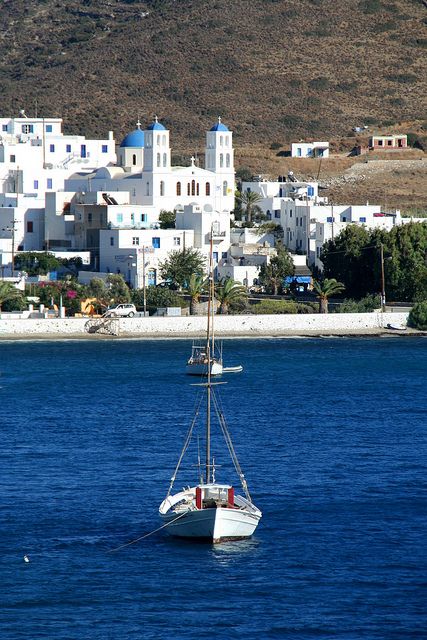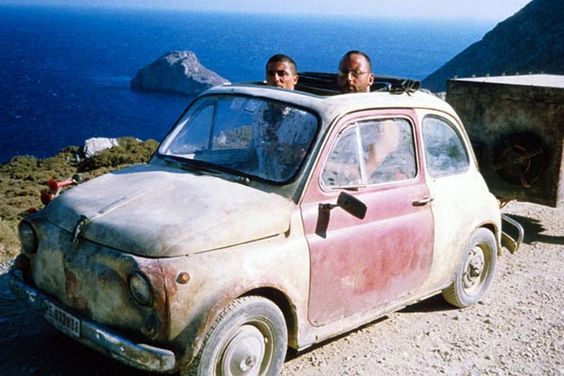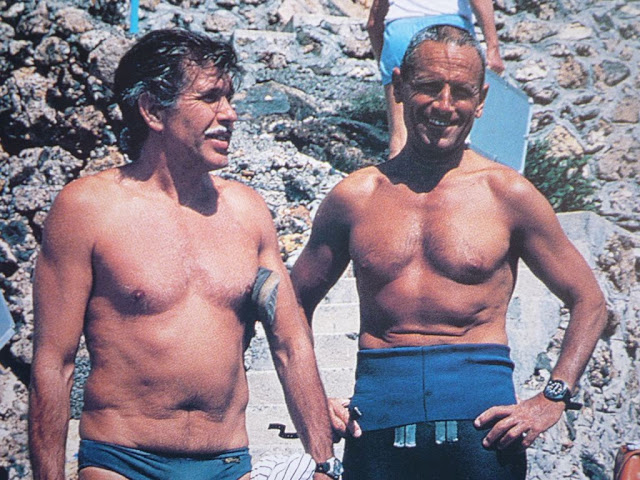The Greek Island of Amorgos – The Big Blue

Amorgos, one of the prettiest islands in Greece
Authentically blue!
If you are thinking of visiting the picturesque Greek island of Amorgos, do try to see the 1988 cult film, directed by Luc Besson, ‘The Big Blue’, before you go.
The film shows the amazing monastery of Panagia Hozoviotissa, perched high on a mountain side, the idyllic Agia Anna beach and Liveros Bay, with the shipwreck of the Olympia which inspired Luc Besson to film on Amorgos.
The shipwreck is in many scenes of the film.
The ship Olympia sank in February 1980 in the small Liveros Bay, close to Kalotaritissa beach whilst the captain was looking for a place near the coast where they could find shelter from the strong north winds, happily all the crew survived.

The bay where the shipwreck is (Image © Miles with Vibes).
‘The Big Blue’ is the film which sparked worldwide interest in free diving for extreme sports enthusiasts and of course the island of Amorgos.
Two minute Trailer below, worth watching!
-e1676920679634.jpg?resize=550%2C309&ssl=1)
Surreal poster for the film The Big Blue 1988
The island of Amorgos
Amorgos, the small, Eastern-most Island of the Cyclades in the South Aegean Sea, accessible only by boat, has incredible views, (owing to heights of more than 800 meters above sea level), pristine sandy beaches and many archeological remains, especially the walls surrounding Arkesini.
Arkesini (Kastri), an ancient acropolis, founded in the 900th century BC was inhabited up until medieval times when people fled from the ever growing threat from pirates.
The small church on the rock is dedicated to Panagia Kastriani (Virgin Mary of the Castle

Acropolis Arkesini. Amorgos Cyclades Greece.
Agia Anna, the rocky beach below the Monastery of Hozoviotissa, outside Chora, named after the church located there, is accessible by car, or is around a thirty minute walk down from the monastery.
Agia Anna, with its deep blue, crystal clear waters is famous for the scenes in the movie “The Big Blue”.

Agia Anna Amorgos Island (Cyclades) Greece
Many famous Dokathismata-styles, Cycladic figures, dating from 2700 BC, were unearthed on the island of Amorgos, mainly in the cemeteries of Agios Pavlos and Agia Paraskevi.

A Cycladic figurine from Amorgos in the National Archaeological Museum at Athens. Ca. 2500 BC.
Amorgos has two ports; the main one; yacht-filled Katapola and the second; Aegiali and one town Chora; known as Amorgos.

Chora Amorgos island, Greece Photo @dounazoe

Amorgpos Cyclades Greece
Amorgos is not really the place for beach lovers but is more of a “back to nature” island, the perfect place for walking, hiking, rock climbing and of course diving.

Katapola, Amorgos. Photo: Leoniedas
The monastery of Panagia Hozoviotissa
The monastery of Panagia Hozoviotissa – The Virgin Mary of Hozova, Amorgos, built hanging on a cliff side 300 meters above the sea in 1027, is one of the oldest monasteries of the Aegean.
It’s said that an icon of the Virgin Mary, from Hozova (hozovo) in Palestine, reached Amorgos on a boat which had washed up on the beach just below where the monastery stands today.
The icon was found by locals and when the news of the find reached Constantinople in 1088, the Emperor ordered that a monastery be constructed on the spot where the icon was found.
Building began but each morning when the builders returned to work, whatever had been built the day before had been mysteriously knocked down.
This went on until one day; the master builder misplaced his bag of work tools only to find it hanging from a nail on the cliff face above.
This was interpreted as a sign from the Virgin Mary that she wished the monastery to be built where the bag was found; hanging from the cliff face; the faithful builders granted her wish!

Monastery of Panagia Hozoviotissa. Amorgos
“The Big Blue”:
Cult film – 1988

Free diving – Amorgos – The Big Blue – 1988
To celebrate thirty years since the making of the original film, “The Big Blue” on Amorgos, in 1988, a documentary, directed by Jerome Espla and, again filmed on Amorgos, is the reason actor Jean-Marc Barr, now aged fifty six, who played Jacques Mayol, twenty nine years ago, is back on Amorgos, to help in production of the documentary and with team promotion.

Actor Jean-Marc Barr (Center) with Freedivers Association AIDA Hellas president Dimitris Koumoulos and vice president Christos Papadopoulos.
“The Big Blue”, is the heavily fictionalized story (In real life, neither diver reached 400 feet, and neither diver died whilst diving), of two friends, Enzio Maiorca (Jean Reno) and Jaques Mayol (Jean-Marc Barr ) both free divers, growing up in Greece in the 1960s, until their deaths in the 1980s.
(Free diving; diving without breathing apparatus, is nothing new, for hundreds of years divers have used this method, diving for sponges, shellfish and pearls).

How it all began. At the beginning of the film “The Big Blue”
Jacques and Enzo challenge each other to collect a coin on the sea floor and Jacques loses.
.jpg)
Jean Reno (Enzo) and Jean-Marc Barr (Jacques) “The Big Blue” (1988)

Friends; Enzo and Jacques and the Fiat 500 used in the film “The Big Blue” 1988
Jaques Mayol

Jacques Mayol 1990
Jacques Mayol (1927-2001), played by actor Jean-Marc Barr, a free diving legend, of French nationality, born in Shanghai, China, was already an experienced diver when he first met Enzio Maiorca.
Maiorca was the first to dive below 50 meters, Mayol reached 60 meters and in 1976 Mayol broke the 100 meters record, with a no-limits dive, of the coast of Elba, Italy.
Tests during the dive showed that amazingly Mayol’s heartbeat dropped from sixty to twenty seven beats per minute, a characteristic of “Mammalian diving reflex”, more noticeable in whales, seals and dolphins!
Mayol’s last dive in 1983, at the age of fifty six, was to a depth of 105 meters.
In 2001, suffering from depression, Mayol hung himself in his villa in Elba.
Enzo Maiorca

Enzo Maiorca
Enzo Maiorca (1931-2016) born Syracuse, Sicily, learned to swim at the age of four and despite his fear of the sea, entered into the world of diving, beginning with spear fishing, which he abandoned in 1967 to concentrate on free diving.
When the two divers; Mayol and Maiorca, reached 76 meters in 1970, the International Diving Federation ruled the depths too dangerous and refused to acknowledge any further records.
Dare-devil Maiorca, defied medical experts by swimming to a depth of more than 91 meters in one breath and in 1988 set his final record at 101 meters.
Maiorca managed to block the release of the film “The Big Blue” in Italy until 2002, a year after Mayol’s death, he thought the film portrayed him as an uneducated Sicilian and ordered certain lines of dialogue removed before the film debuted in Italy.

Enzo Maiorca und Jacques Mayol
World record for free diving
The current world record for free diving is held by Austrian Herbert Nitsch, known as “The deepest man on earth”

Herbert Nitsch, World Record Holder Free diver
Herbert Nitsch, with his best dive of 214 meters (328 ft), the world record, also has another sixty nine official world records to his name!
Related Post:
The naked sponge divers of Kalymnos



